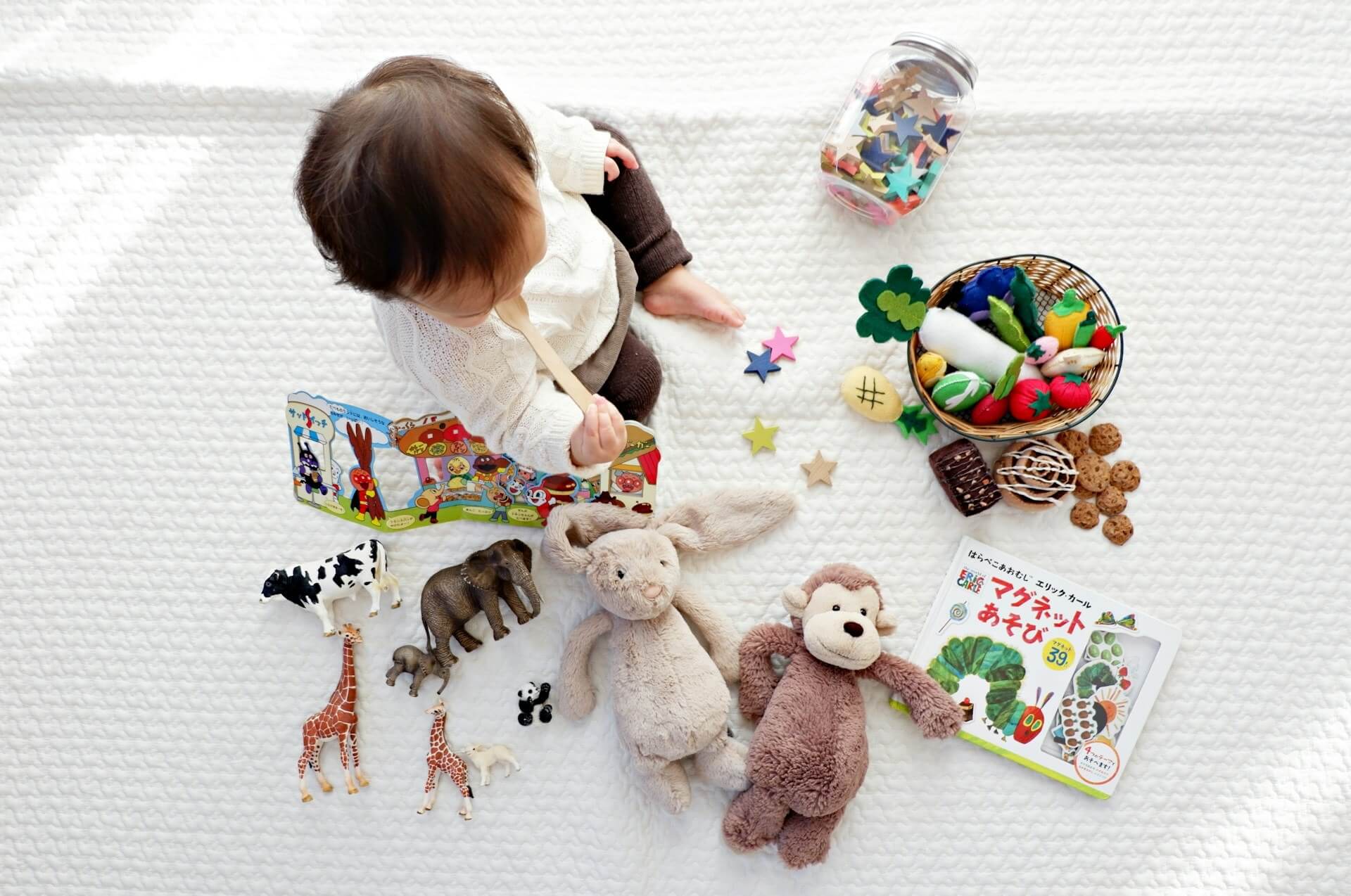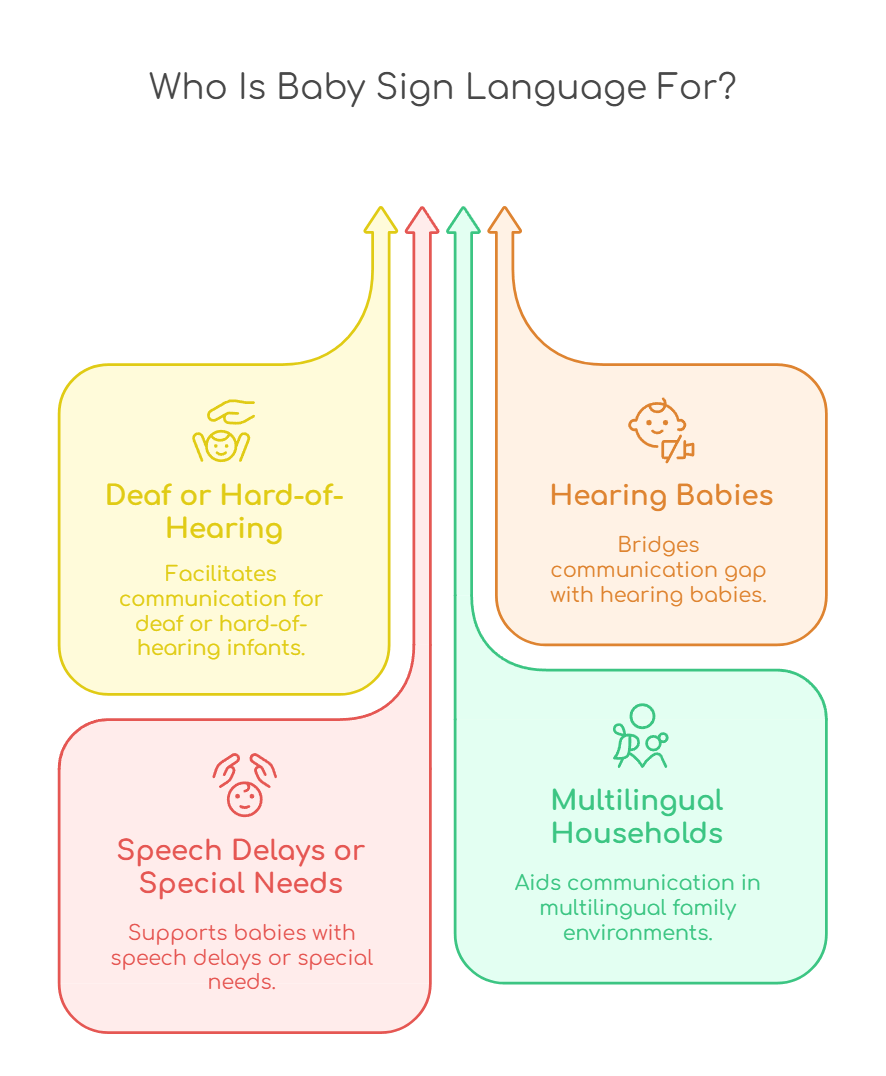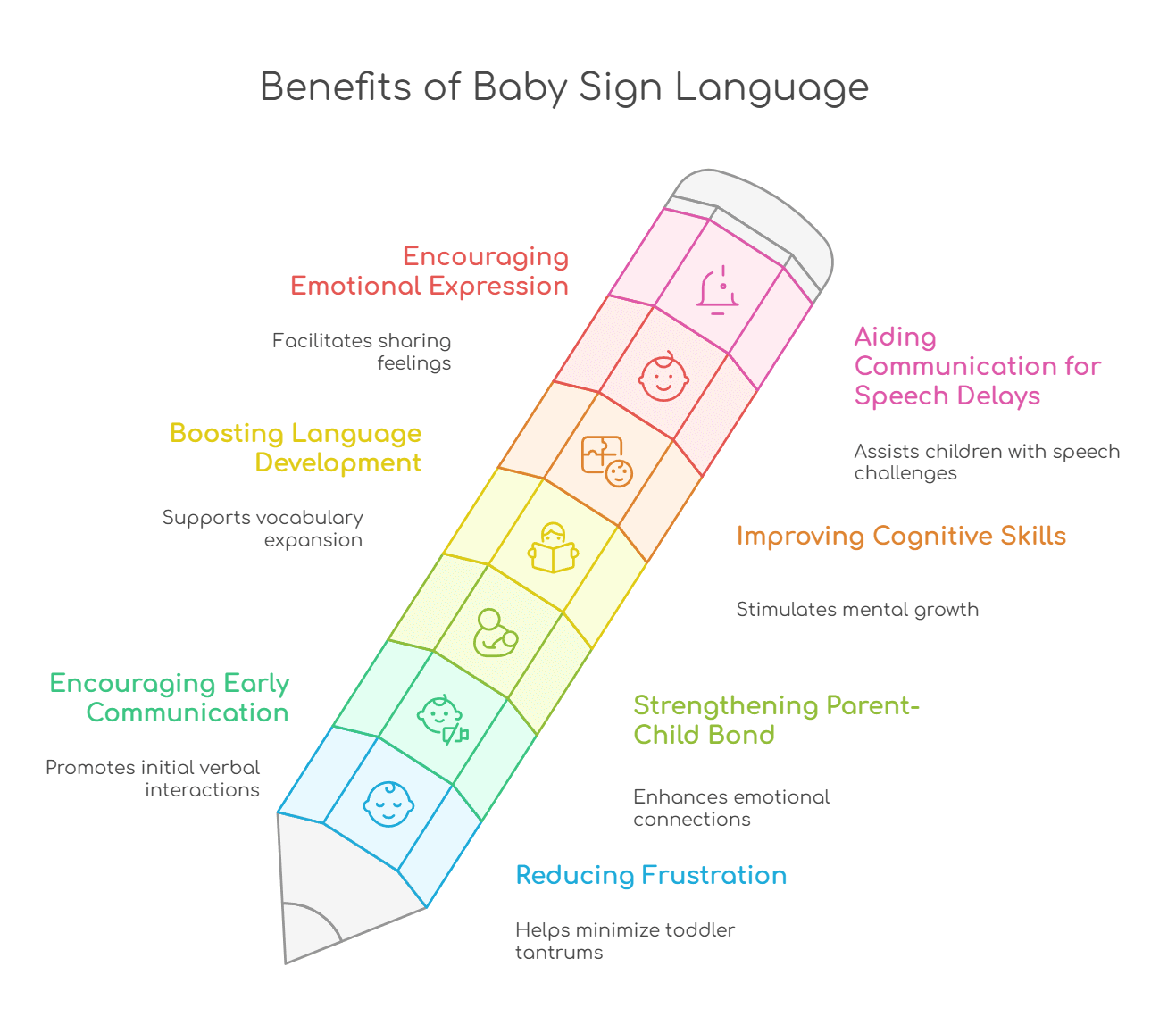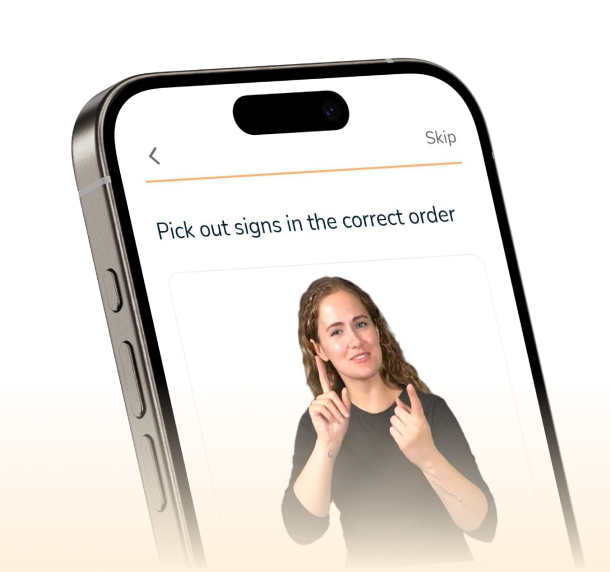Baby sign language: How does sign language for babies work
Read this article to understand how baby sign language works and how it helps infants communicate. Learn simple signs to use with your baby.

Baby sign language is a way of communicating with infants and toddlers using simple signs. It helps babies express their needs, feelings, and observations. It's beneficial for both hearing and Deaf babies, promoting early language development and easing communication. Babies typically start signing around eight to 12 months and transition to spoken words as they grow.
Imagine if your baby could tell you they're hungry, sleepy, or need a diaper change without crying.
Baby sign language can help with that. It provides a simple yet meaningful way for infants to communicate their needs before they can speak.
It's possible to teach your baby to express herself/himself through basic signs.
This doesn't only help build a deeper connection with the parents or caregivers. It also makes early communication much less frustrating.
This article is for both first-time parents and those looking for new ways to engage with their little ones.
Using baby sign language in daily routines can be a rewarding experience.
In this blog, we'll look at how baby sign language works, its key benefits, and practical tips for getting started.
What is baby sign language?
Baby sign language is a method of early communication that allows infants to express their needs and feelings before they can speak.
They can do this using simple signs.
It's not an entirely separate sign language. It's rather a simplified version of sign language commonly used in that region.
It includes only basic signs that are practical for a baby's daily needs.
It's often based on American Sign Language (ASL), British Sign Language (BSL), or other regional sign languages.
So, if you're wondering, "Is baby sign language the same as ASL?" the answer is that it's a simplified version of ASL.
Baby sign language focuses only on keywords that are useful for daily interactions. This makes it easier for babies to learn and use signs.
Parents and caregivers can teach babies signs for common words. For example:
- Milk
- Mom
- Dad
- Eat
- More
- All done
- Sleep
Babies watch and imitate the signs. Then, they gradually start using them to communicate before they can form words.
Baby sign language is, naturally, less dependent on grammar.
Full sign languages have their own grammatical structures. But baby sign language is more about isolated words rather than full sentences.
Who is baby sign language for?
Baby sign language is essential, but not limited to, babies who are Deaf and Hard of Hearing (HOH).
Parents can also use sign language to communicate with their babies before they start speaking.
So, baby sign language can be used to communicate with:
- Deaf or Hard-of-Hearing babies
- Hearing babies
- Babies with speech delays or special needs
- Babies that come from multilingual households

Many parents teach their hearing babies sign language.
Doing so helps them express themselves. This is very useful before the baby develops verbal skills.
Speech development takes time. Signing provides a way for babies to communicate their needs.
In other words, fewer tantrums and a smoother daily routine.
Sign language is key for early language development for Deaf and Hard-of-Hearing babies.
Teaching them signs early ensures they have access to communication from the start. This is key in cognitive and social development.
In many cases, baby sign language is the foundation for learning a complete sign language, like ASL.
It can also be useful for children with speech delays, developmental delays, and autism.
In any of these cases, sign language can serve as an alternative communication method.
Baby sign language can act as a bridge between languages. This is very important for bilingual and multilingual households.
Signs are visual and consistent. They help babies connect words across different spoken languages.
This makes language learning a smoother process.
How to teach your infant sign language
Teaching your baby sign language can be a fun and rewarding experience.
Here's a step-by-step guide to getting started:
- Start with a few basic signs
Begin with simple and useful signs that relate to daily activities. Common first signs include "milk," "more," "eat," and "all done." Choose signs that your baby will use often.
- Be consistent
Repetition is key. Always use the sign while saying the word aloud and performing the action. For example, when giving your baby milk, say "milk" while signing it.
- Use signs in context
Make sure to sign at the right moment. If your baby is reaching for food, use the "more" sign before giving them another bite. This reinforces learning through real-life experiences.
- Encourage and respond
When your baby starts attempting signs, encourage them. Even if they don't do the sign perfectly at first, make sure to praise their efforts.
- Be patient
Every baby learns at their own pace. Some may start signing back within a few weeks, while others take longer. Most babies begin using signs around 6 to 9 months.
- Make it fun
Engage your baby with songs, books, and interactive play to reinforce signs in an enjoyable way. Some ideas include singing songs while signing or reading books and pointing out signs in illustrations.
- Expand signs gradually
Once your baby masters a few signs, introduce new ones for emotions, objects, and people. Keep adding signs as their understanding grows.
- Involve everyone
Encourage caregivers and family members to use signs with your baby. The more people use sign language around them, the quicker they will learn.

Benefits of baby sign language
Teaching your baby sign language offers numerous advantages, from reducing frustration to enhancing early learning.
Here are some of the key benefits:
- Reducing frustration and tantrums
- Encouraging early communication
- Strengthening parent-child bond
- Boosting language development
- Improving cognitive skills
- Encouraging emotional expression
- Aiding communication for children with speech delays

Babies often get frustrated when they can't express their needs.
Baby sign language helps them communicate before they can speak. This reduces crying, whining, and tantrums.
Sign language bridges the gap between understanding words and being able to say them.
Babies can understand language months before they can form words. Signing allows them to communicate earlier than with speech alone.
Using baby sign language creates more meaningful interactions between you and your baby.
By responding to your baby's signs, you reinforce their trust and confidence.
Contrary to myths, baby sign language does not delay speech. It often enhances it.
Studies suggest that babies who use sign language may:
- Learn words faster
- Have a larger vocabulary
- Develop better language skills as they grow
Signing gives babies a visual and kinesthetic way to remember words, making learning easier.
Using signs helps babies develop critical thinking and problem-solving skills.
They learn to associate symbols with meaning, which strengthens memory, focus, and learning abilities.
Babies often struggle to express emotions like happiness, sadness, fear, or tiredness. Teaching them emotional signs helps them communicate their feelings.
Signing can be an alternative communication tool for babies with:
- Speech delays
- Autism
- Down syndrome
- Other developmental conditions
It allows them to express themselves without relying solely on spoken words.
When can babies learn sign language?
Many parents introduce signs around six months. However, babies typically start signing back around 8 to 10 months.
The timeline for understanding and using signs varies for each child.
You can expose your baby to sign language as soon as they are born. Babies are too young to sign back until they are 4 months old.
But they are absorbing everything around them. Parents can start using simple signs during daily routines.
From four to 6 months, they start to understand.
Around this time, babies start developing stronger hand-eye coordination and memory. This allows them to recognize and associate signs with meanings.
They may not sign back just yet. But, they will start watching your hands closely and showing excitement when they understand a sign.
They may start to sign when they are 6 to 9 months old.
At first, their signs might be imperfect or modified. But with encouragement, they will refine their gestures.
From 9 to 12 months, they will be able to learn many more signs. This is because their fine motor skills start to improve at this time.
When they're between 12 to 18 months, they can combine signs with spoken words.
Many toddlers naturally transition from signing to verbal communication. However, signing remains useful for clarity, learning new words, and expressing emotions.
Teaching ASL to Deaf and Hard-of-Hearing babies
Deaf and Hard-of-Hearing children must develop strong communication skills from an early age.
That's why it's important to expose them to ASL when they're still babies.
The earlier you introduce sign language, the better. Even newborns can benefit from seeing signs in their daily routines.
The best time to start is:
- 0-6 months for exposure
- 6-9 months for understanding
- 9-12 months for signing back
It's also important to use ASL in daily routines. That way, your baby can see sign language in action.
Since Deaf and Hard-of-Hearing babies rely on visual cues, it's important to get their attention before signing.
You can do this by:
- Making eye contact
- Gently tapping their shoulder
- Using facial expressions and exaggerated movements
Sign language isn't just about hands. It relies heavily on facial expressions and movement to convey meaning.
These elements are also called non-manual markers.
Babies learn through repetition, so sign keywords every time you say them. The more often they see a sign, the faster they will recognize and use it.
If you are a hearing parent of a Deaf or Hard-of-Hearing baby, connecting with Deaf mentors, educators, or sign language instructors can be helpful.
They can guide you on best practices and support your baby's language journey.
The importance of ASL for babies
Baby sign language is a valuable and effective tool that allows infants to communicate their needs and emotions before they develop verbal skills.
Whether you have a hearing baby, a Deaf or Hard-of-Hearing baby, or a child with speech delays, signing offers many benefits.
By starting early, being consistent, and making signing a fun, natural part of daily life, parents, and caregivers can create a stronger bond with their babies.
Teaching sign language is not only practical but also empowering.
ASL Bloom is here to help parents teach their babies ASL at whatever pace they choose.
With our interactive, gamified ASL lessons, you can teach your child one sign at a time. We also offer video lessons for even better learning.
You can download our app for free on the App Store or Google Play.
Start Learning ASL Today
Start your ASL learning journey today! Download the ASL Bloom app and take the first step toward learning American Sign Language.

Start Learning ASL Today
Start your ASL learning journey today! Download the ASL Bloom app and take the first step toward learning American Sign Language.
.webp)


.png)